Why Understanding Mortuary Cooling Tables is Essential for Modern Funeral Homes
A mortuary cooling table is a specialized piece of equipment designed to temporarily preserve and display deceased bodies through controlled cooling, with modern versions offering refrigerated storage while antique models relied on ice placement beneath perforated wooden platforms.
Quick Reference for Mortuary Cooling Tables:
- Primary Function: Preserve bodies at 34-40°F to slow decomposition
- Modern Types: Self-contained refrigerated units, no drainage required
- Antique Types: Wooden platforms with cane latticework, used ice blocks
- Capacity Options: 2-body to 6-body configurations available
- Price Range: $6,829+ for modern units, up to $5,999 for antique collectibles
- Key Features: Height adjustment, mobile casters, stainless steel construction
- Power: Standard 110V plug-in for most modern units
The history of mortuary cooling tables traces back to 19th-century "cooling boards" - perforated wooden platforms where families placed ice beneath to preserve loved ones during home funerals. These portable tables allowed morticians to make house calls, folding up with handles for easy transport between homes.
Today's funeral directors face a choice between investing in antique cooling tables as collectibles or purchasing modern refrigerated units that meet current health regulations. While companies like B.F. Gleason and Enterprise MFG Co. produced thousands of these wooden tables in the 1800s, contemporary manufacturers focus on stainless steel, self-contained cooling systems.
As American Mortuary Coolers, a national-level mortuary cooler supplier, we've helped funeral homes across the country steer the transition from traditional cooling methods to modern refrigerated solutions.
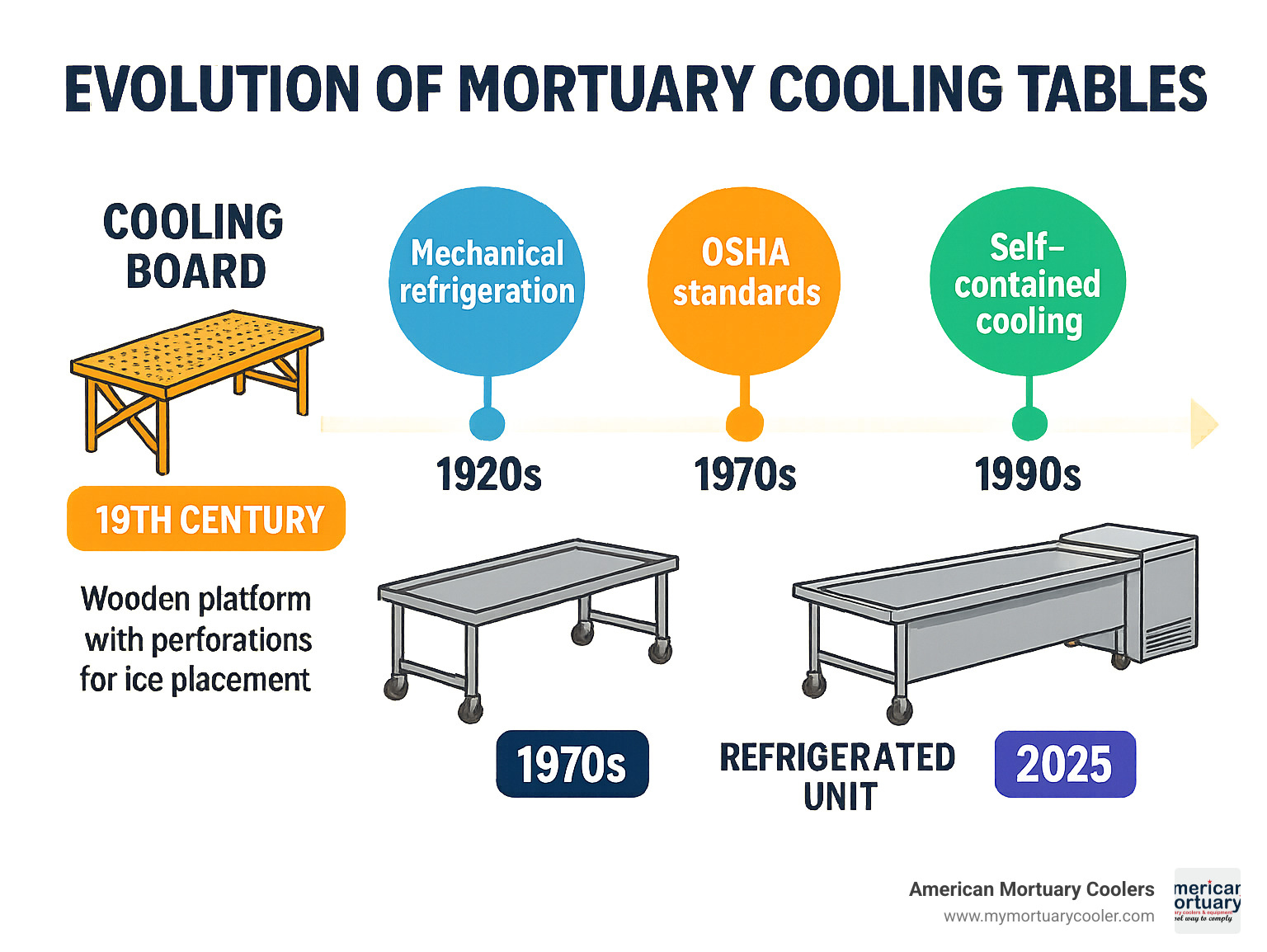
Understanding the Mortuary Cooling Table: Purpose and Origins
The mortuary cooling table has one crucial job: keeping deceased bodies properly preserved while families prepare for final farewells. These weren't always the sleek stainless steel units we see today.
In the 1800s, they were called "cooling boards" - wooden platforms with intricate cane latticework designed to hold ice blocks underneath while allowing cold air to flow around the body above. Those perforations and cane lattice patterns created essential airflow while providing drainage channels for melting ice.
These cooling tables became essential during the era of home funerals, when families handled everything in their front parlors. The portability factor was genius - undertakers traveled from house to house with folding cooling boards that collapsed to just 21" × 15" × 4⅝" but opened to accommodate a full-sized adult.
More info about cooling tables
What Makes a "mortuary cooling table" Unique?
A mortuary cooling table isn't just furniture - it's precision equipment designed around three critical features:
Airflow design remains the heart of any cooling table. Original cane lattice tops created natural air circulation, while today's refrigerated models use blower plenums and forced-air systems for greater precision.
Drainage capabilities set these tables apart. Historical models featured grooves and channels that directed fluids toward collection points, while modern units often eliminate drainage needs through improved sealing.
Portability features continue to matter. Whether it's folding mechanisms of antique models or mobile casters on contemporary units, funeral directors need to move equipment between spaces.
Historical Significance of the Mortuary Cooling Table
The cooling table played a starring role in Victorian death culture, when mourning was elaborate and extended. The Civil War changed American funeral practices, sparking advances in embalming techniques while cooling tables remained essential for families who couldn't afford professional services.
One remarkable example from Appalachian history shows families placing bodies on cooling boards in unheated barns during winter, waiting for spring thaw to allow burial. This Appalachian practice shows how essential cooling tables became in pre-refrigeration America.
Undertaker house calls defined an era when funeral professionals arrived at homes with portable cooling equipment, setting up temporary preservation stations in parlors across the country.
From Cooling Boards to Refrigerated Technology
The journey from ice-filled cooling boards to sophisticated refrigerated tables took nearly a century. In the early 1900s, most funeral homes still relied on ice delivery and wooden cooling boards because mechanical refrigeration was expensive and unreliable.
Real change began in the 1920s-1930s when funeral homes grew larger and more centralized. World War II accelerated everything - the post-war boom brought new technologies, and smaller, efficient compressors in the 1960s made individual refrigerated tables practical.
Modern regulations pushed the industry toward refrigerated solutions. OSHA codes and CE standards favor controlled, predictable environments over variable ice conditions. Today's units maintain precise 28-41°F temperatures - impossible with ice blocks.
Embalming development More info about table options
Comparing Antique Cooling Tables and Modern Units
The differences go far beyond cooling methods:
Materials: Antique tables used solid oak frames with hand-woven cane latticework and brass hardware - furniture-quality pieces for family parlors. Modern units use stainless steel construction with powder-coated exteriors and high-density insulation.
Size differences reflect demographic changes. Antique tables were smaller (around 41⅝" × 15") because people were generally shorter. Modern tables accommodate contemporary body sizes with bariatric options available.
Functionality: Antique tables required manual ice placement every few hours with no temperature control. Modern units feature digital controllers, automatic defrost, and self-contained operation.
| Feature | Antique Cooling Tables | Modern Refrigerated Units |
|---|---|---|
| Cooling Method | Ice blocks beneath platform | Mechanical refrigeration |
| Temperature Control | None (ambient dependent) | Digital controllers (±1°C) |
| Materials | Oak wood, cane latticework | Stainless steel, insulation |
| Drainage | Required (perforations/grooves) | Self-contained, no drainage |
| Power Requirements | None | 110V standard outlet |
| Maintenance | Ice replacement, cleaning | Periodic compressor service |
| Typical Price | $1,000-$5,999 (collectible) | $6,829-$15,000+ (new) |
Design Variations and Key Features You Should Know
When shopping for a mortuary cooling table, you'll find design options that have evolved to meet changing funeral service needs.
Traditional folding boards were engineering marvels that transformed from full-sized tables into compact packages measuring just 21" × 15" × 4⅝". These included adjustable headrest flaps for dignified positioning.
Fixed platforms gained popularity as funeral homes established permanent locations, offering stability and sophisticated drainage systems. Mobile units with casters now provide the best of both worlds - rolling smoothly when needed but locking securely for stability.
Blower plenum systems represent important safety advances, actively capturing harmful vapors while ensuring even temperature distribution. Height adjustment features transform physically demanding work into something more manageable for staff.
Stainless steel construction has become the gold standard. Grade 304 stainless steel resists corrosion, cleans easily, and meets health department requirements for food-grade surfaces.
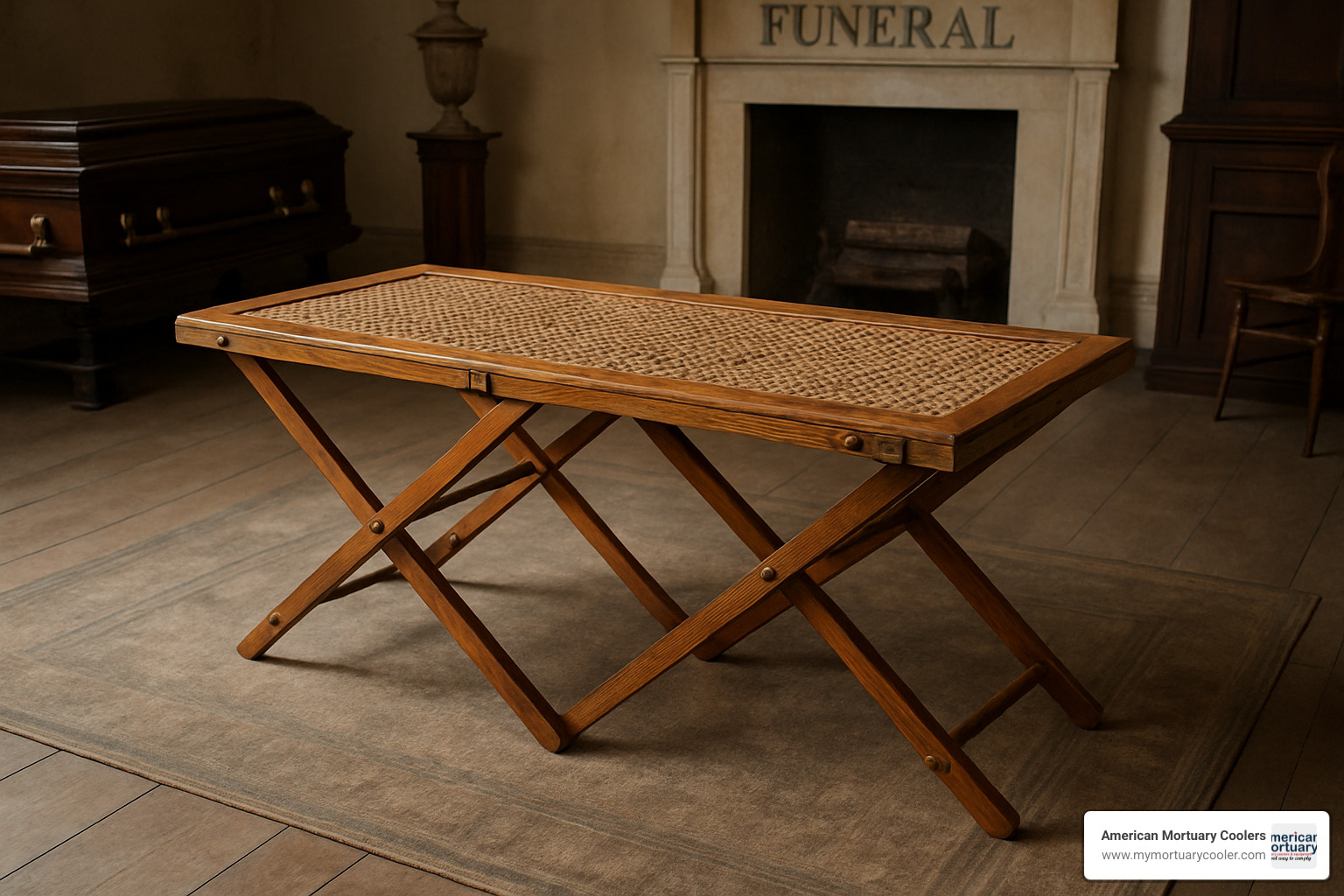
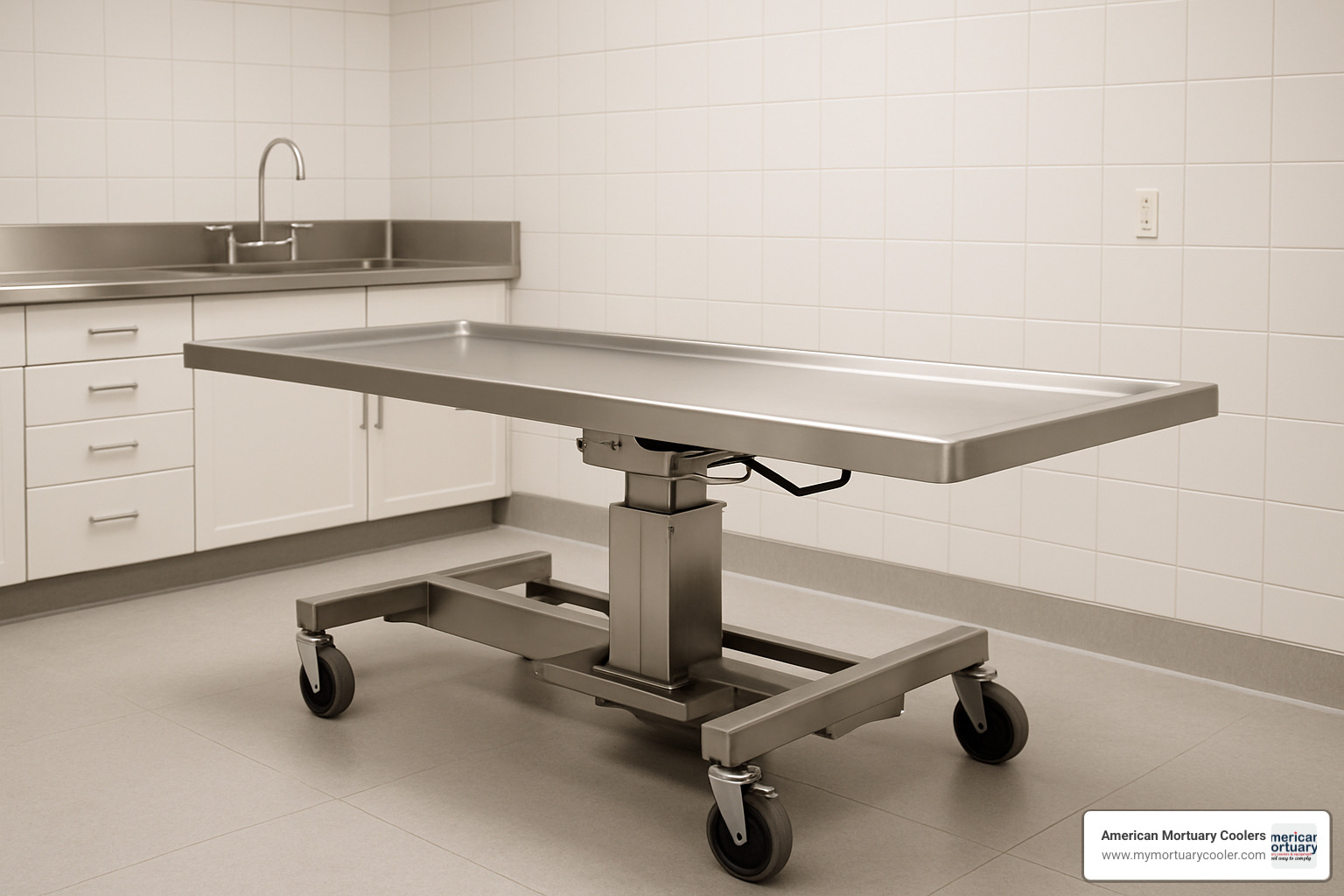
Specialty "mortuary cooling table" Models on Today's Market
Today's mortuary cooling table market has expanded beyond basic cooling:
Autopsy-compatible tables serve forensic communities with improved drainage and removable tops for thorough cleaning. Viewing and display models focus on family interaction with attractive exteriors that feel less clinical.
Modular top systems offer Swiss Army knife versatility - a single unit transforms from embalming table to viewing platform to storage solution. Bariatric models feature reinforced construction for larger individuals, while pediatric units provide appropriately scaled dimensions for tragic situations involving children.
Cooling Table for Funeral Home guide
Body Preservation Process, Safety & Regulations
Properly preserving bodies on cooling tables requires creating a safe, dignified environment that meets strict health regulations.
Temperature control forms the foundation - maintain a steady 34-40°F range to slow bacterial growth without freezing tissue. Modern refrigerated units handle this automatically, but ice-based systems need constant monitoring and ice replacement every 12-24 hours.
When placing ice on traditional tables, distribution matters more than quantity. Large blocks should sit evenly beneath the platform with smaller pieces filling gaps for uniform cooling without direct ice-to-skin contact.
Personal protective equipment becomes critical. Always wear appropriate gloves, eye protection, and protective clothing. The cooling process generates condensation that can harbor dangerous pathogens.
Sanitation protocols vary between units. Stainless steel tables withstand aggressive EPA-approved disinfectants, while wooden tables require gentler cleaning. Modern environmental regulations require EPA-approved refrigerants and energy efficiency standards.
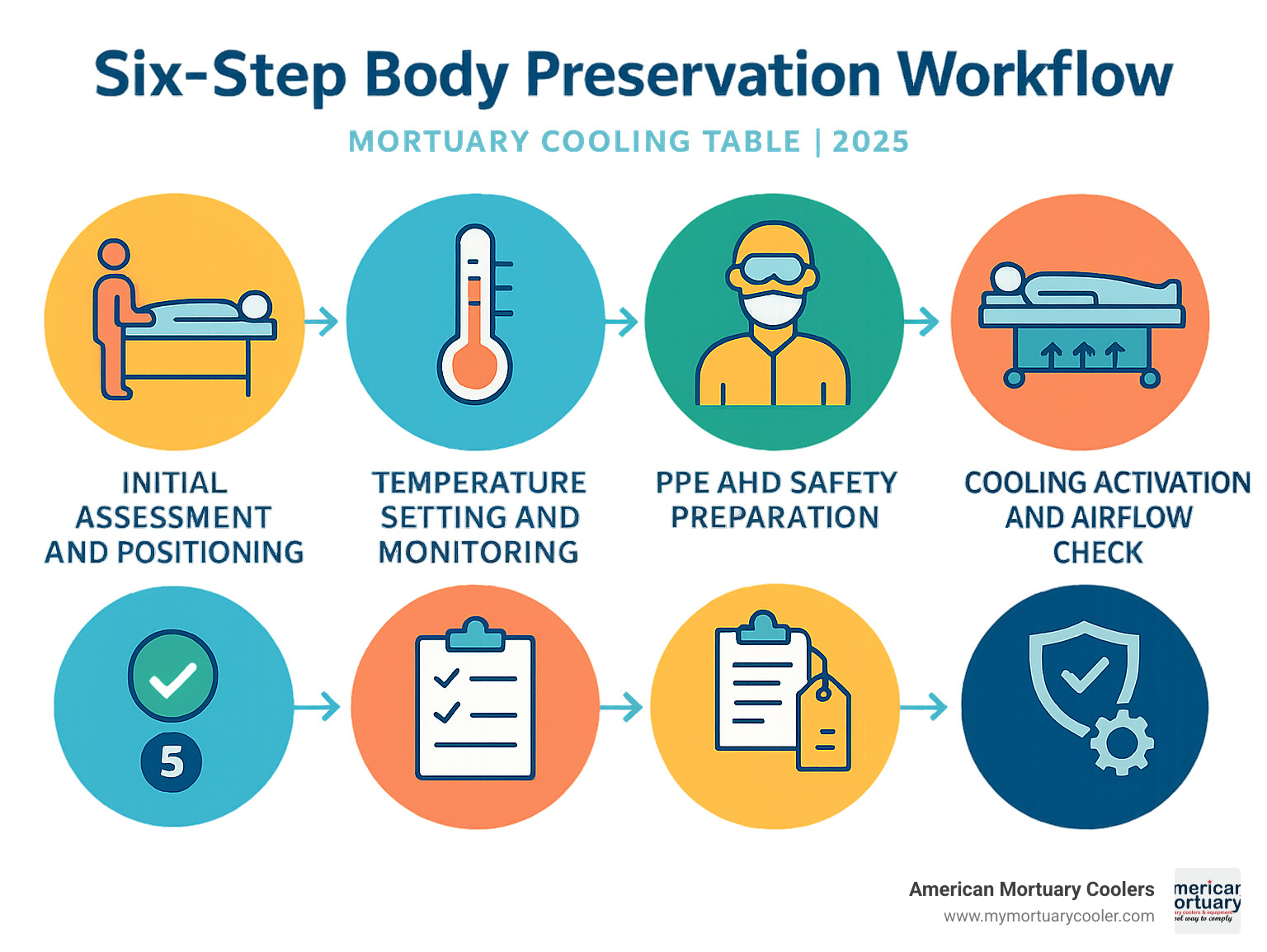
Hygiene and Operator Safety Protocols for Mortuary Cooling Tables
Biohazard control starts with understanding how cooling tables create environments where dangerous materials accumulate. Drainage systems become breeding grounds if not maintained, while air circulation systems can spread contaminants if filters aren't changed.
Disinfection procedures should use EPA-registered disinfectants that eliminate viruses, bacteria, and fungi. Clean obvious surfaces plus areas around cooling mechanisms, drainage systems, and air vents where biological materials hide.
State health code compliance varies dramatically but typically addresses minimum temperature requirements, sanitation standards, and operator certification. Ventilation requirements should provide 6-12 air changes per hour depending on state requirements.
Buying Guide: Antique Collectibles vs. Modern Professional Tables
Choosing between antique and modern cooling tables is like deciding between a classic car and a new truck - both have their place, but your needs determine which makes sense.
The pricing landscape is interesting: beautifully preserved antique tables with original brass hardware cost up to $5,999, while new 2-body refrigerated coolers start around $6,829.
For antique collectors, condition is everything. Structural integrity matters most - loose joints and cracked wood create expensive headaches. Original hardware like brass fittings boosts value, while provenance documentation makes collectors pay more. Hand-woven cane condition deserves special attention because authentic repair is nearly impossible.
Modern professional tables offer advantages antiques can't match. Warranty coverage typically includes 15-year panel warranties and 5-year mechanical parts coverage. Energy efficiency means standard 110V operation costing about $50-100 monthly.
Regulatory compliance is where modern units shine - they meet OSHA standards and health department requirements without workarounds. The return on investment shows up in unexpected ways: no staff hauling ice, no water damage, consistent preservation, and professional appearance.
At American Mortuary Coolers, our Tennessee-based manufacturing creates custom solutions with direct delivery across the contiguous 48 states.
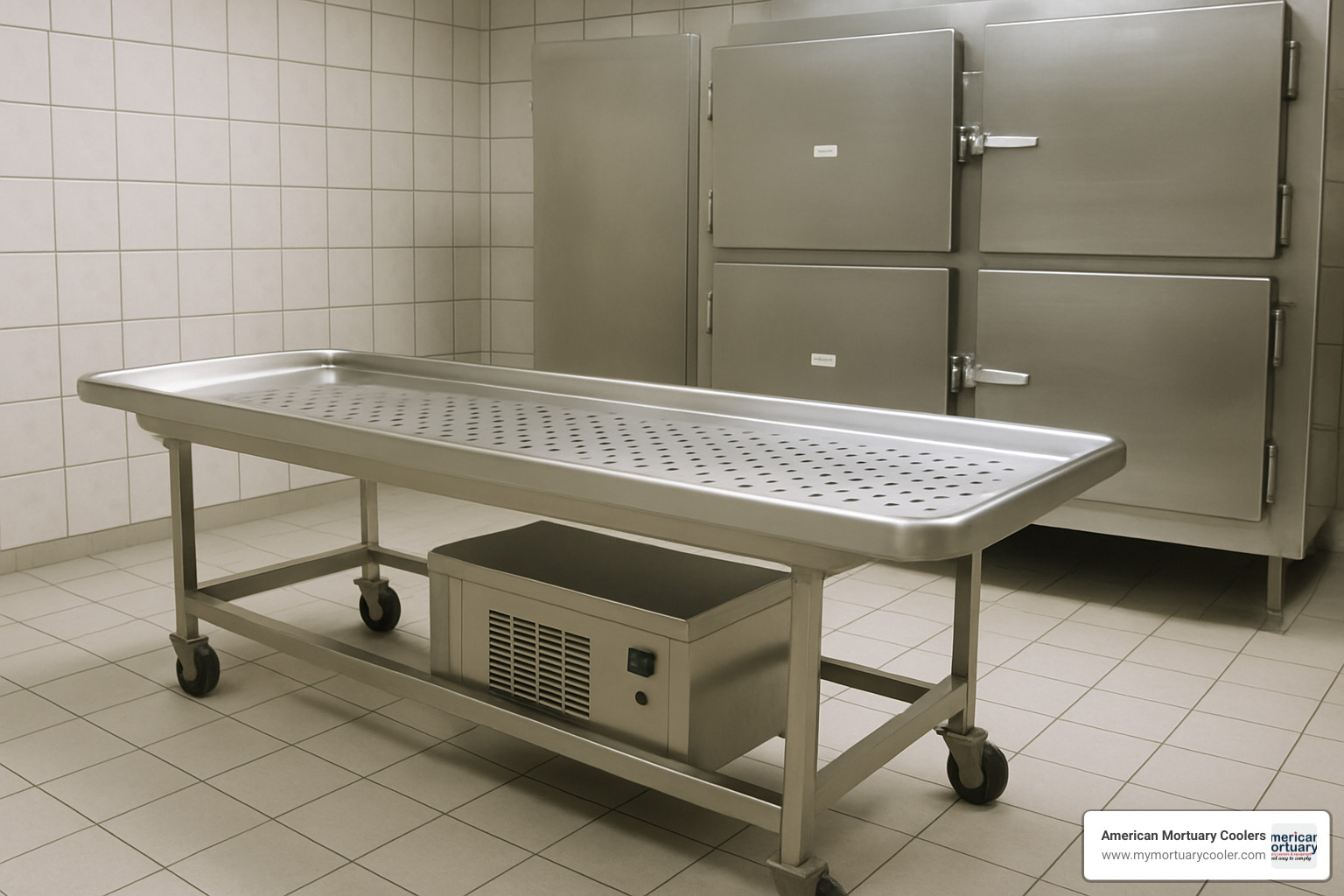
Key Questions Before You Purchase a "mortuary cooling table"
Before purchasing any mortuary cooling table, ask these hard questions:
Space requirements go beyond measuring the table. Can you open folding tables fully? Modern units need clearance for ventilation and service access. Check doorways for larger multi-body units.
Power and utility needs can be deal-breakers. Most need standard 110V outlets, but larger units might require dedicated circuits. Check electrical capacity before falling in love with that 6-body cooler.
Mobility requirements often get overlooked. Tables with casters offer flexibility but sacrifice stability. Capacity planning requires honest volume assessment - consider peak demand periods, not just average needs.
Resale value considerations matter more than realized. Modern equipment depreciates 20-30% initially, while well-maintained antiques often appreciate as collectibles.
Frequently Asked Questions about Mortuary Cooling Tables
How long can a body remain on a cooling table safely?
With proper temperature maintenance between 34-40°F, most bodies can remain safely preserved for 24-72 hours without significant deterioration.
Modern refrigerated units give you the best chance of reaching that full 72-hour window through steady automatic temperature control. Ice-based systems require constant monitoring and regular ice replacement, with temperature swings shortening safe storage time.
Several factors affect preservation effectiveness: ambient room temperature, condition of the body when placed, and your intended next steps.
Are antique cooling tables legal to use today?
Most antique cooling tables cannot legally be used for actual body preservation in modern funeral operations. State health departments typically require temperature-controlled refrigeration meeting specific standards.
However, antique tables make fascinating historical displays and excellent educational tools for explaining funeral service history. Many funeral directors use them in lobbies as conversation pieces.
If considering using an antique table for operations, contact your state health department and licensing board first.
What maintenance does a modern refrigerated table require?
Weekly sanitation forms the maintenance backbone - use EPA-approved disinfectants and clean all surfaces after each use.
Monthly compressor checks help catch problems early. Listen for unusual noises and verify stable temperatures. Quarterly gasket inspection prevents costly repairs - door seals losing integrity force cooling systems to work harder.
Annual professional service provides peace of mind and often satisfies warranty requirements. Technicians check refrigerant levels, inspect electrical systems, and calibrate temperature controls.
At American Mortuary Coolers, we provide detailed maintenance schedules with every unit and arrange service calls across the contiguous 48 states.
Conclusion
Choosing the right mortuary cooling table comes down to understanding your specific needs. If you're a collector fascinated by funeral history, antique cooling tables with hand-woven cane tops tell an incredible story - well-preserved examples can be worth up to $5,999. But if you're running an active funeral home, modern refrigerated units starting around $6,829 will serve your families far better.
For collectors and museums, look for antique tables with original maker's plaques. For working funeral homes, modern refrigerated units offer the reliability and regulatory compliance you need. For emergency backup, stick with modern units - you can't afford equipment failure when families are counting on you.
The real cost isn't just the purchase price. Modern cooling tables eliminate ice hauling labor, provide consistent temperatures, and come with warranty protection. When you factor in energy costs, maintenance, and peace of mind, modern units typically offer better long-term value.
At American Mortuary Coolers, we've worked with funeral homes across the country making this exact decision. Our Tennessee-based manufacturing creates exactly what your funeral home needs with direct delivery to your door.
The transition from 19th-century cooling boards to today's refrigerated tables represents our industry's commitment to honoring tradition while meeting modern standards of care. Whether upgrading decades-old equipment or opening a new location, the right cooling table becomes part of how you serve families during their most difficult moments.
We'd love to discuss your specific needs. Every funeral home is different, and the right mortuary cooling table is an investment in both your daily operations and the dignified service families deserve.
More info about our mortuary coolers
The cooling table remains one of the most essential pieces of equipment in funeral service, representing our industry's dedication to caring for families when they need us most.
















